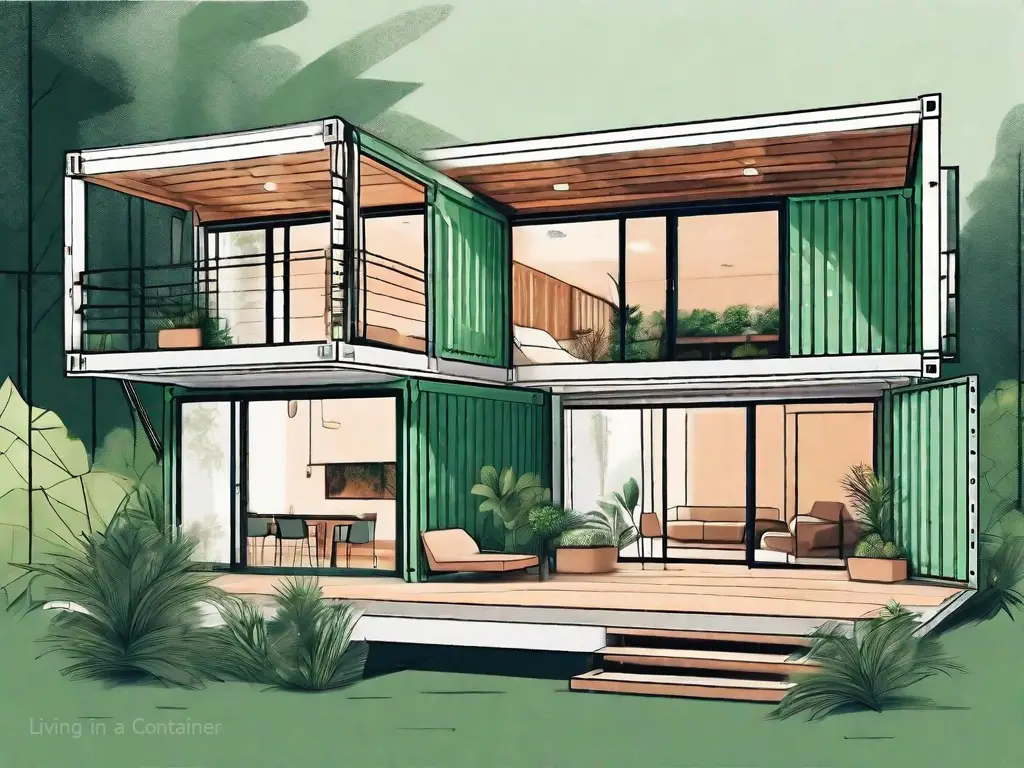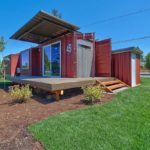Container homes have gained popularity in recent years as a unique and affordable housing option. Whether you’re looking to downsize, reduce your carbon footprint, or simply have a one-of-a-kind living space, building a container home can be an exciting and fulfilling project. In this article, we will explore the concept of container homes, the benefits and potential challenges they present, the pre-construction considerations you need to take into account, the design process, and the construction process. With the right knowledge and planning, you can turn your dream of living in a container home into a reality.
Understanding the Concept of Container Homes
Container homes have gained popularity in recent years as a unique and innovative approach to residential construction. These homes are constructed using repurposed shipping containers, which are typically made of steel and designed to withstand the harsh conditions of ocean transportation. By repurposing these containers, individuals and architects have found a creative way to build functional and aesthetically pleasing living spaces.
When it comes to container homes, the possibilities are endless. The containers can be stacked and modified in various ways to create multi-level structures, offering a modern and industrial architectural style. The exterior of the containers can be left as is, showcasing the rugged texture and industrial charm, or they can be painted and adorned with different materials to blend in with the surrounding environment.
What is a Container Home?
A container home, as the name suggests, is a residential structure constructed using repurposed shipping containers. These containers, originally designed for transporting goods across the globe, provide a strong and durable foundation for building homes. The steel construction ensures the structural integrity of the containers, making them a reliable choice for housing.
Container homes are not limited to a specific size or layout. Depending on the number of containers used, the design possibilities are vast. From compact single-container homes to spacious multi-container complexes, these homes can be tailored to meet the needs and preferences of the homeowners.
Benefits of Container Homes
There are several advantages to building a container home. Firstly, containers are readily available and relatively inexpensive compared to traditional building materials. With an abundance of shipping containers sitting idle in ports around the world, repurposing them for housing helps reduce waste and contributes to a more sustainable lifestyle.
In addition to their affordability and sustainability, container homes offer the benefit of portability. Unlike traditional homes, which are fixed to a specific location, container homes can be easily transported to a new site if desired. This flexibility allows homeowners to embrace a nomadic lifestyle or simply relocate to a different area without the hassle of selling or buying a new property.
Furthermore, container homes are highly customizable. The modular nature of the containers allows for endless design possibilities. Whether it’s adding windows, doors, or even joining multiple containers together, homeowners can create a space that reflects their unique style and caters to their specific needs.
Potential Challenges of Container Homes
While container homes have many benefits, there are some challenges to consider. One of the main concerns is insulation and temperature control. Containers, being made of steel, tend to retain heat in warm weather and cold in colder climates. Proper insulation and weatherproofing measures must be implemented to ensure a comfortable living environment throughout all seasons.
Another challenge is the size and layout limitations of containers. While they can be stacked and combined to create larger spaces, the dimensions of individual containers may require careful planning and creative solutions to maximize the available area. Designing efficient storage solutions and optimizing the flow of the living space are crucial aspects to consider when building a container home.
Lastly, it’s important to be aware of the legal and zoning restrictions that may apply to container homes. Regulations regarding the use of shipping containers for residential purposes vary by location. Before embarking on a container home project, it’s essential to research and comply with local building codes and regulations to avoid any legal complications.
Pre-Construction Considerations
Before embarking on the exciting journey of building your container home, there are several important factors to consider. These pre-construction considerations will help ensure that your project is a success and that your container home meets all your needs and expectations.
Choosing the Right Container
One of the first steps in building a container home is selecting the right containers for your project. It’s essential to carefully inspect the containers for any signs of damage or rust that could compromise their structural integrity. You want to ensure that the containers you choose are in good condition and will provide a solid foundation for your home.
Additionally, consider the size of the containers and how they will fit into your overall design. You’ll need to determine if the dimensions of the containers are suitable for your intended layout and if they provide enough height for comfortable living spaces. Take into account the number of containers needed to accommodate your desired floor plan and make any necessary adjustments.
Legal and Zoning Issues
Before you start building, it’s crucial to familiarize yourself with local building codes and zoning regulations. Different areas may have restrictions or guidelines on the use of shipping containers for residential purposes. By understanding these regulations, you can ensure that your plans comply with the law and avoid any potential legal issues or delays in the construction process.
Consult with local authorities or seek professional advice to ensure that your container home project meets all the necessary requirements. This will give you peace of mind and help you move forward with confidence.
Site Preparation and Planning
Once you have obtained any necessary permits and ensured compliance with local regulations, it’s time to prepare the site for construction. This involves clearing the land and leveling the area where the container home will be placed.
During the planning phase, carefully consider the layout and orientation of the containers. Take advantage of natural light and optimize energy efficiency by strategically placing windows and doors. Think about the flow of the space and how you want the different areas of your home to connect.
Furthermore, consider the placement of utilities such as plumbing, electricity, and HVAC systems. Planning their locations in advance will ensure functionality and make the construction process smoother.
Remember, the site preparation and planning stage is crucial for the overall success of your container home project. Take the time to carefully think through all the details and make any necessary adjustments to create a home that is not only functional but also aesthetically pleasing.
Designing Your Container Home
Basic Design Principles
When designing your container home, it’s important to prioritize functionality, comfort, and aesthetics. Start by creating a floor plan that suits your lifestyle and incorporates essential living areas such as bedrooms, bathrooms, kitchen, and living spaces. Utilize the open floor concept to maximize the feeling of space within the limited area of the containers. Consider natural lighting and ventilation options to create a bright and airy environment.
Customizing Your Space
One of the advantages of container homes is the ability to customize the space according to your taste and needs. Whether you prefer a minimalist design, an industrial look, or a cozy cabin feel, choose finishes, materials, and colors that reflect your personal style. Incorporate storage solutions to make the most of your space, and consider multifunctional furniture to optimize functionality.
Incorporating Sustainable Features
In line with the eco-friendly nature of container homes, consider incorporating sustainable features into your design and construction. Explore the use of renewable energy sources such as solar panels, rainwater harvesting systems, and energy-efficient appliances. Utilize eco-friendly building materials and insulation to minimize the environmental impact of your home. Using recycled or reclaimed materials can also add a unique and vibrant touch to your interior design.
The Construction Process
Foundation and Structural Work
Building a solid foundation is essential for the stability and longevity of your container home. Consult with a structural engineer to determine the appropriate foundation type based on your soil conditions and local building regulations. Prepare the site and pour the foundation, ensuring that it is level and capable of supporting the weight of the containers. Connect the containers securely to the foundation and reinforce them to provide structural stability.
Insulation and Weatherproofing
Proper insulation and weatherproofing are crucial for maintaining comfortable living conditions within your container home. Apply high-quality insulation materials to the interior, exterior, and in between the container walls to minimize temperature fluctuations and reduce energy consumption. Install weather-resistant barriers and sealants to prevent moisture infiltration and protect against the elements.
Interior Finishing and Aesthetics
With the structural work and insulation in place, it’s time to focus on the interior finishing touches. Install drywall or other wall finishes to create a polished and welcoming ambiance. Choose flooring that is durable, easy to maintain, and complements the overall design of your home. Install plumbing and electrical systems, ensuring that they meet the necessary safety standards. Personalize your space with furnishings, decorations, and artwork that reflect your style and enhance the functionality of each room.
Building a container home offers a unique opportunity to create a space that meets your specific needs while reducing environmental impact. From understanding the concept of container homes to designing and constructing your dream container home, this article has provided an overview of the process involved. Remember to plan diligently, consult with professionals when needed, and enjoy the journey of transforming shipping containers into a comfortable and stylish home that truly reflects your imagination and lifestyle.
You may love to read!
How To Build an Off Grid Cabin on a Budget
How To Extend Your House With A Shipping Container
Container House Design How to Make Your Interior Cozy & Warm?
Can I build my own Shipping Container Home? – Step by Step Inspiration






